In his 1974 essay “Technology of Writing,” William Burroughs advised new writers, “One more thing: Sinclair Lewis said: ‘If you want to be a writer, learn to type.'” This was neither facetious nor an avoidance of the question. By Lewis’s day, and certainly by Burroughs’s, the basic skill of typewriting had become as necessary as handwriting in the preceding centuries for anyone launched on a writing career.
What had originated as genuine manuscripts, in the literal sense of the word (manu=hand, script=writing) had by the 1920s become typescripts. When the 20th century got going, professional usage everywhere — book publishing, magazines, newspapers — all expected material to arrive in typewritten form. (We might remember that Mark Twain, seeing the future, believed in the typewriter, invested in its manufacture, and in 1883 submitted Life on the Mississippi to his publisher in typewritten form.) We still refer, anachronistically, to pre-publication drafts of texts as manuscripts, but I’ll wager that editors and publishers stopped accepting handwritten material three-quarters of a century ago, if not even earlier.
So unless one could afford a secretary to transcribe handwritten texts to typed pages (as Twain did), the 20th-century writer needed to know how to type, for purely practical reasons. Submitting material for publication meant submitting it as typescript. But I like to think that Lewis had something beyond the economics of the writer’s life in mind when he made his helpful suggestion.
Seeing a typewritten text, as distinct from a handwritten one, gave the writer some foretaste of how his or her writing would appear in print — an approximation of how it would look to the reader once typeset and issued for consumption on the published page. This anticipatory experience of the material’s move from the private sphere of the writer’s desk to the permanence and public life of printed matter surely affects the writer’s conception of the work.
•
Some writers have actually had the privilege of witnessing that transformative moment, myself among them. Few writers make a point of going to the shop or factory where their work gets typeset for publication. But those of us who worked on or for newspapers in the pre-digital era (a list that includes authors as diverse as Ernest Hemingway and Thomas Harris), or who worked for printing shops during the era of letterpress and linotype printing, got to experience that transition in a visceral, material way.
In a post several years ago I recounted my own earliest role as a published writer, working for (and eventually editing) my college’s newspaper, the Hunter Arrow, in the early 1960s. As a staffer, I spent countless hours on the premises of Citywide Printers, the grimy, low-ceilinged street-level Lower East Side print shop where we produced the paper.
One memorable aspect of that involvement I wrote about in a 1994 essay, “An Arranged Marriage: My Life with the Computer,” as follows:
My favorite part of it [editing and supervising the production of that paper] was watching the Linotype operator set something I’d written myself. If I stood at the side of the machine, I could observe out of one eye as his hands flew over his keyboard, entering in my text from the typescript before him; with the other eye, I could see the slugs of hot lead drop down a slot, my words in metal, fixed, permanent, ineradicable.
Seeing my writing in print changed me, to put it mildly. And by the time I started to think seriously about writing as a component of my life, the step before achieving print had become, except in increasingly rare cases, the typewritten page.
In fact, those decades, the 1950s and ’60s, saw an explosion of “little” magazines, small-press and self-published books, and other publications — mostly literary, some political — printed directly from typewritten matrices without ever getting typeset, using such methods as mimeograph stencils, plates made from photographing typed pages, and the thin metal plates of the AB Dick Offset Printing Press. (My parents started their publishing enterprise on the last of those. I helped my father Earl run ours in that project’s early days, so I began mainlining printer’s ink before I’d turned ten.)
•
Others of his generation and subsequent ones would take Lewis’s understanding a step or more further:
- Poets such as e. e. cummings would use typographic devices common to the typewriter but not to handwriting as elements in their work; cummings’s poems were self-evidently composed on the typewriter, indeed inconceivable (in every sense of the word) without that instrument.
-
Don Marquis would make the inability of archy, his lightweight cockroach alter ego, to depress the manual typewriter’s shift key into a structural device in his “archy & mehitabel” poems.
- The poet and Melville scholar Charles Olson would discuss the typewriter as an instrument for the composition of poetry and its relation to the page as field.
- James Laughlin, founder of New Directions, the press that published Olson, Pound, and many other modernists, said, “We are typewriter, and now word-processer, people,” in a 1983 interview in The Paris Review.
- Speaking of his own poetry, Laughlin described himself as a “typewriter versifier.” He invented and worked within a form in which every line of a poem could be only two typewriter spaces longer or shorter than the first typewritten line.
- Laughlin recalled that William Carlos Williams had told him, “The typewriter is the vehicle of the new age and you better use it.”
- Frank O’Hara of the New York School of poetry would assert that he liked to “play the typewriter” for a few hours after breakfast.
-
William Burroughs would devise his recombinant “cut-up” process for slicing up and reordering pages of typewritten prose, most famously used in his novel Naked Lunch (1959).
- Mark Harris would turn a defective typewriter into a plot device in his epistolary 1959 novel Wake Up, Stupid.
- Writers of both poetry and fiction would start to employ the full range of characters on the typewriter keyboard — ampersands, asterisks, percent signs — in their texts.
- Concrete poetry would engage the typewriter as instrument even more formally, exploring not just the entire assortment of characters on the keyboard but also the possibilities of typing one character over another and many other typographic/graphic effects specific to the typewriter as a writing tool. (Indeed, though various forms of visual poetry preceded the invention of the typewriter, it’s impossible to imagine concrete poetry without the typewriter.)
•
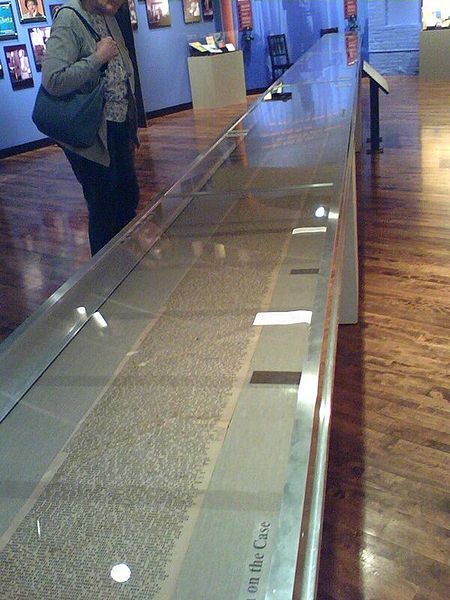
The original manuscript (a 120-foot scroll) of Jack Kerouac’s ‘On The Road’, photographed on August 19, 2007 at an exhibition in Lowell, MA. Courtesy Creative Commons.
With these thoughts in mind, let us move to Jack Kerouac’s famous typescript “scroll” of his legendary 1957 novel On the Road, for which he used a 120-foot roll of tracing paper instead of the U.S. standard 8-1/2 x 11″ sheet of paper. Kerouac had cut the tracing paper sheets to size and taped them together to make this scroll.
This artifact has been on display numerous times over the past several decades. I first saw it in a show at the Whitney Museum, “Beat Culture and the New America: 1950-1965” (Nov. 9, 1995-Feb. 4, 1996). More recently it got shown at the New York Public Library, in a show titled “Beatific Soul: Jack Kerouac on the Road” (Nov. 9, 2007-March 16, 2008.) Currently it’s on view in London, at the British Library, as part of show on Beat Generation literature. (Click here for a short video about the scroll and its installation there.)
It’s an iconic artifact, due to the cultural impact of its content, but its treatment (however reverential) as an oddball experiment has masked its maker’s insight into the technology of writing and its prophetic relationship to his medium’s future.
An already established young writer of the same generation as Kerouac but of a much different temperament, Truman Capote, cavalierly dismissed Kerouac’s “spontaneous bop prosody” with the words “That’s not writing — it’s typing.” He knew not how true he spoke, nor how radical an insight into the writing process — and specifically the writing process in its typewritten version — Kerouac’s choice represented.
Kerouac, who had taken Sinclair Lewis at his word, could touch-type 100 words per minute — about as close to the speed of thought as a typist can get. He didn’t compose On the Road from scratch, as some mistaken legends had it; though he wrote it at white heat, he drew on extensive notebooks he’d kept for years, his equivalent of a visual artist’s sketchbooks, for substantial portions.
Nor did he have any impulse to make a thing meriting attention in and of itself, a significant object for his audience to experience as such. Why, then, take the trouble to hand-craft this scroll and then write a whole book on it?
•
This post supported by a donation from the Estate of Lyle Bongé.



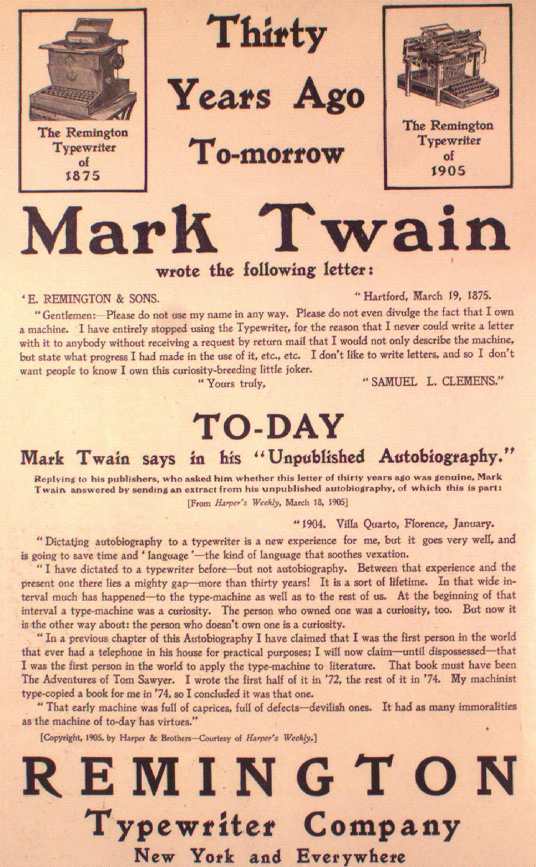
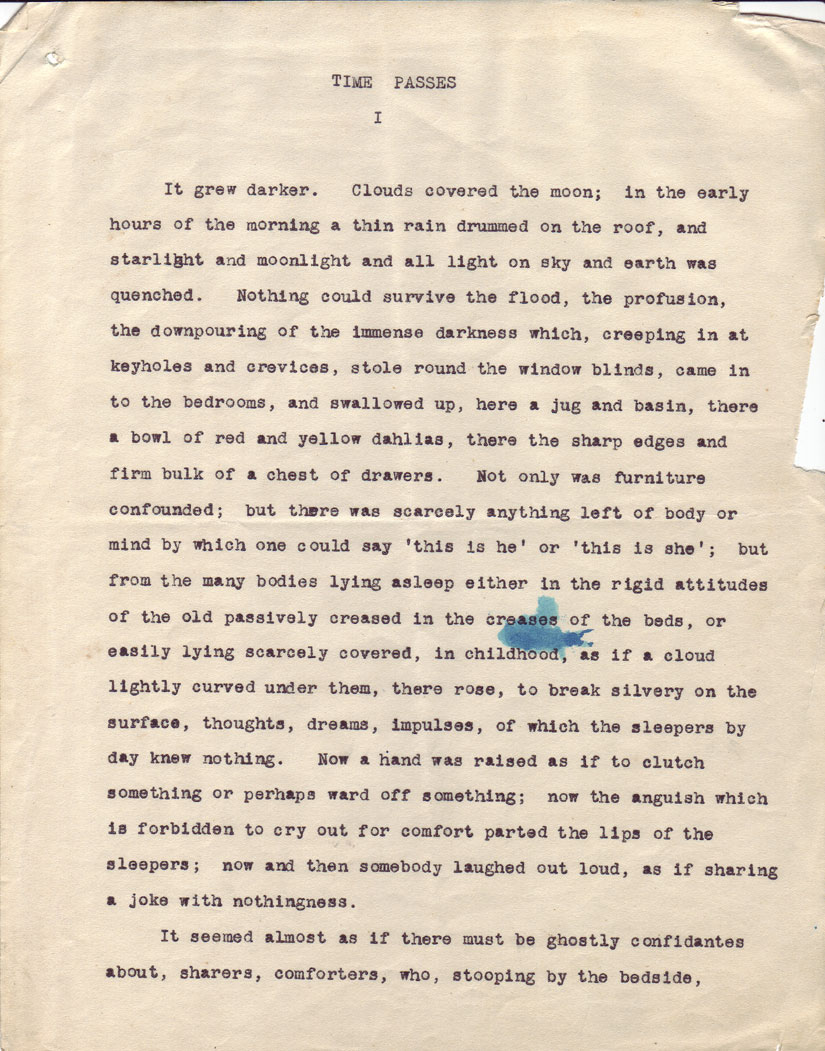
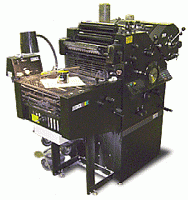
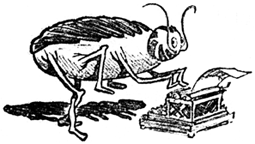
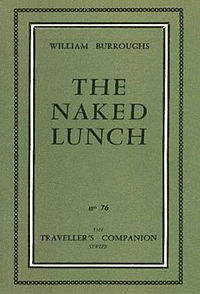
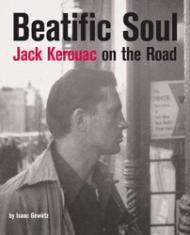




Allan,
You are amazing. A fascinating perspective.
In grad school when we considered dissertation topics in German history one consideration was whether the topic fell in a period before or after documents were typewritten (much easier afterwards). I never wrote that dissertation but started The Photo Review instead.
I also recall a Lewis Carroll concrete poem – http://en.wikipedia.org/wiki/The_Mouse's_Tale.
Best,
Stephen
Part 2 coming up shortly.
The people I know who study this stuff (e.g., Dick Higgins) refer broadly to “visual poetry” as the general tendency, examples of which predate not just the typewriter but even printing. The term “concrete poetry” emerged in the 1950s, as a movement with manifestos, etc.
Not that they deny their antecedents (to the contrary). But I think Wikipedia should more accurately classify Carroll’s “A Mouse’s Tale” as a visual poem/visual poetry, to avoid anachronism. It does prove that, even without a typewriter, an author could visualize how something handwritten would appear when set in type.
Dear AD —
Brings back a memory or two. When I worked on the newspaper in NOLA I also got the chance to watch the Linotypist drop my words out in hot lead too. My favorite part was hearing that solid clank of the metal letters falling into place. It gave the echo of the imperishable to one’s writing efforts.
Best for the Holidays,
— Roy